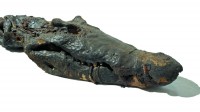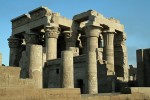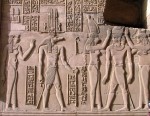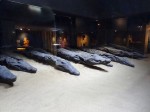 The British Museum has performed a new study of a 2,500-year old crocodile mummy which is now on display for the first time in 75 years. Scanning Sobek: Mummy of the Crocodile God, is one of The Asahi Shimbun Displays, a series of short exhibitions that explore objects in a new light. In this case, visitors will get to see the crocodile itself and the new information about the creature’s life and death revealed in the study.
The British Museum has performed a new study of a 2,500-year old crocodile mummy which is now on display for the first time in 75 years. Scanning Sobek: Mummy of the Crocodile God, is one of The Asahi Shimbun Displays, a series of short exhibitions that explore objects in a new light. In this case, visitors will get to see the crocodile itself and the new information about the creature’s life and death revealed in the study.
 The mummy is a Nile crocodile that dates from 650 – 550 B.C. and is four meters (13 feet) long. It was mummified after death, dried in natron and then coated in beeswax and pitch before being wrapped in linen bandages. The mummy was a representation of the god Sobek, the crocodile-headed deity which symbolized the power of the pharaoh, fertility, military strength and protection from harm. Crocodiles, which lay as many as 80 eggs in one clutch and which ferociously protect their young, carrying hatchlings on their backs or even in their mouths, were seen as great generators and guardians, powers that took godly form in Sobek and the pharaoh. The British Museum mummy has more than 25 mummified hatchlings on its back, representing that combination of generative and protective power evinced by the Nile crocodile.
The mummy is a Nile crocodile that dates from 650 – 550 B.C. and is four meters (13 feet) long. It was mummified after death, dried in natron and then coated in beeswax and pitch before being wrapped in linen bandages. The mummy was a representation of the god Sobek, the crocodile-headed deity which symbolized the power of the pharaoh, fertility, military strength and protection from harm. Crocodiles, which lay as many as 80 eggs in one clutch and which ferociously protect their young, carrying hatchlings on their backs or even in their mouths, were seen as great generators and guardians, powers that took godly form in Sobek and the pharaoh. The British Museum mummy has more than 25 mummified hatchlings on its back, representing that combination of generative and protective power evinced by the Nile crocodile.
 It was one of about 300 crocodile mummies discovered in the Per-Sobek temple in Kom Ombo, a site about 30 miles north of Aswan in southern Egypt, and in the neighboring animal necropolis of el-Shatb. The Kom Ombo temple was the largest and most important center of worship of Sobek in Egypt during the Ptolemaic and Roman eras. Built in the 2nd century by Ptolemy VI Philometor on the site of an earlier temple to Sobek by 18th Dynasty Pharaoh Thutmose III (r. 1479–1425 B.C.), the unique symmetrical double temple had two sections, the southern one dedicated to Sobek, the northern to falcon god Horus the Elder. The necropolis, with hundreds of crocodile graves cut into the hard rock, was in continuous use from the Middle Kingdom through the Greco-Roman period.
It was one of about 300 crocodile mummies discovered in the Per-Sobek temple in Kom Ombo, a site about 30 miles north of Aswan in southern Egypt, and in the neighboring animal necropolis of el-Shatb. The Kom Ombo temple was the largest and most important center of worship of Sobek in Egypt during the Ptolemaic and Roman eras. Built in the 2nd century by Ptolemy VI Philometor on the site of an earlier temple to Sobek by 18th Dynasty Pharaoh Thutmose III (r. 1479–1425 B.C.), the unique symmetrical double temple had two sections, the southern one dedicated to Sobek, the northern to falcon god Horus the Elder. The necropolis, with hundreds of crocodile graves cut into the hard rock, was in continuous use from the Middle Kingdom through the Greco-Roman period.
 The temple bred sacred crocodiles, the mummified eggs and juveniles used as votive offerings to the god. Sacred crocodiles bred at the temple were treated with kid gloves, adorned with jewels and hand-fed. Worshipped as the incarnation of the god himself, they lived out their natural lives and were mummified after death. They were probably as tame as fearsome Nile crocodiles could get. In Book XVII of his Geography, Strabo describes priests feeding a sacred crocodile in Crocodilopolis, modern-day Faiyum, the largest center of cult worship for Sobek.
The temple bred sacred crocodiles, the mummified eggs and juveniles used as votive offerings to the god. Sacred crocodiles bred at the temple were treated with kid gloves, adorned with jewels and hand-fed. Worshipped as the incarnation of the god himself, they lived out their natural lives and were mummified after death. They were probably as tame as fearsome Nile crocodiles could get. In Book XVII of his Geography, Strabo describes priests feeding a sacred crocodile in Crocodilopolis, modern-day Faiyum, the largest center of cult worship for Sobek.
[T]here is a sacred one there which is kept and fed by itself in a lake, and is tame to the priests. It is called Suchus; and it is fed on grain and pieces of meat and on wine, which are always being fed to it by the foreigners who go to see it. At any rate, our host, one of the officials, who was introducing us into the mysteries there, went with us to the lake, carrying from the dinner a kind of cooky and some roasted meat and a pitcher of wine mixed with honey. We found the animal lying on the edge of the lake; and when the priests went up to it, some of them opened its mouth and another put in the cake, and again the meat, and then poured down the honey mixture. The animal then leaped into the lake and rushed across to the far side; but when another foreigner arrived, likewise carrying an offering of first-fruits, the priests took it, went around the lake in a run, took hold of the animal, and in the same manner fed it what had been brought.
 The Kom Ombo temple was in ruins from Nile flooding, earthquakes and centuries of stone quarrying for building projects when it was cleaned, restored and rebuilt as much as possible by French engineer and archaeologist Jacques de Morgan in 1893, then acting Director of Egyptian Antiquities. A selection of the surviving crocodile mummies from Kom Ombo are on display in the new Crocodile Museum near the temple that opened in 2012. The British Museum’s crocodile mummy was discovered during Jacques de Morgan’s work on the site and donated to the museum in 1895.
The Kom Ombo temple was in ruins from Nile flooding, earthquakes and centuries of stone quarrying for building projects when it was cleaned, restored and rebuilt as much as possible by French engineer and archaeologist Jacques de Morgan in 1893, then acting Director of Egyptian Antiquities. A selection of the surviving crocodile mummies from Kom Ombo are on display in the new Crocodile Museum near the temple that opened in 2012. The British Museum’s crocodile mummy was discovered during Jacques de Morgan’s work on the site and donated to the museum in 1895.
 The mummy was scanned at the Royal Veterinary College using high-resolution computer tomography. The scans were used to create a 3D model displaying the details of the crocodile’s insides and the contents of his stomach confirms at least part of Strabo’s account.
The mummy was scanned at the Royal Veterinary College using high-resolution computer tomography. The scans were used to create a 3D model displaying the details of the crocodile’s insides and the contents of his stomach confirms at least part of Strabo’s account.
Not all organs were removed by the embalmers and the stomach contents – the remains of the crocodile’s last meal – are still present. The crocodile appears to have been fed select cuts of meat prior to death, including a cow’s shoulder bone and parts of a forelimb.
Exact replicas of these bones – 3D printed from the scan data – are displayed next to a four-metre CT scan visualisation of the crocodile. The bones were found inside the stomach along with numerous small irregular-shaped stones, which the crocodile swallowed for ballast and to assist digestion, as well as several unidentified small metal objects.
